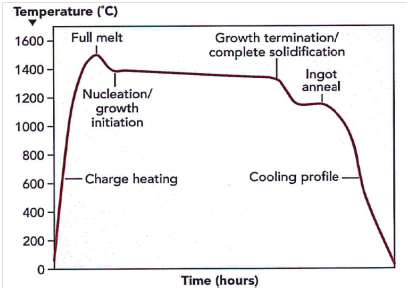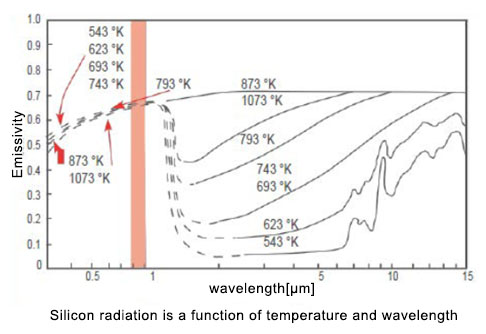
Privacy statement: Your privacy is very important to Us. Our company promises not to disclose your personal information to any external company with out your explicit permission.
86-0519-85506598
Project
1. Overview
Polycrystalline silicon is a form of elemental silicon, and its purity is lower than that of monocrystalline silicon. It can be used as a raw material for pulling monocrystalline silicon. Polysilicon is produced by a polysilicon ingot furnace.
The production of polysilicon is to load high-purity polysilicon material into an ingot furnace, and after vacuuming, the silicon material is melted into a liquid state, and the silicon material forms a vertical temperature gradient through the automatic operation of the ingot furnace. Liquid silicon slowly recrystallizes from bottom to top, forming a large-grained poly-single-crystal ingot silicon. After the silicon ingot is annealed and cooled, it is released from the furnace to complete the entire ingot casting process.
At present, the main traditional processes for polysilicon production in the world are: modified Siemens method, silane method and fluidized bed method. Among them, the production capacity of polysilicon produced by the improved Siemens process accounts for about 80% of the world's total production capacity. The production process takes the modified Siemens method as an example:
(1) Loading
Place the ceramic crucible with the coating on the heat exchange table (cooling plate), put in an appropriate amount of silicon raw material, and then install heating equipment, heat insulation equipment and furnace hood, and vacuum the furnace to make the furnace pressure reduced to (0.05-0.1) mbar and keep the vacuum. Lead into argon gas as a protective gas to maintain the pressure in the furnace at about (400-600) mbar.
(2) Heating
Using a graphite heater to heat the furnace body, first evaporate the moisture adsorbed on the surface of the graphite parts (including heaters, crucible plates, heat exchange tables, etc.), heat insulation layer, silicon raw materials, etc., and then slowly heat up to make the temperature of the ceramic crucible reaches about 1200℃~1300℃, this process takes about 4h~5h.
(3) Chemical materials
The argon gas is used as a protective gas to keep the pressure in the furnace basically at (400-600) mbar. Gradually increase the heating power so that the temperature in the ceramic crucible reaches about 1500°C, and the silicon raw material starts to melt. During the melting process, keep temperature at about 1500°C until the end of the material melting. This process takes about 9-11h.
(4) Crystal growth
After silicon raw material melt is completed, reduce the heating power to make the temperature of the ceramic crucible drop to about 1420℃~1440℃ silicon melting point. The ceramic crucible gradually moves downwards, or the heat insulation device gradually rises, so that the crucible is slowly separated from the heating zone, forming heat exchange with the surroundings; at the same time, the cooling plate is filled with water, so that the temperature of the melt starts to decrease from the bottom, and the crystalline silicon is at the bottom first. It forms and grows upward in a columnar shape. During the growth process, the solid-liquid interface always remains parallel to the water surface until the crystal growth is completed. This process takes about 20h-22h.
(5) Annealing
After the crystal growth is completed, due to the large temperature gradient at the bottom and top of the crystal, thermal stress may exist in the ingot, which may easily cause the silicon chip to break during the silicon chip processing and battery preparation. Therefore, after the crystal growth is completed, the crystal ingot is kept near the melting point for 2h to 4h to make the temperature of the crystal ingot uniform to reduce thermal stress.
(6) Cooling
After the crystal ingot is annealed in the furnace, turn off the heating power, raise the heat insulation device or lower the crystal ingot completely, and pass a large flow of argon into the furnace. The crystal temperature is gradually reduced to near room temperature; at the same time, the pressure in the furnace gradually rises until it reaches the atmospheric pressure, and finally remove the crystal ingot. This process takes about 10 hours.
For cast polysilicon weighing 250-300kg, the general crystal growth speed is about (0.1-0.2) mm/min, and the crystal growth time is about 35-45h.
The heating curve is as follows:

2. Polysilicon infrared temperature measurement

Silicon material is relatively difficult to detect, the corresponding relationship between silicon radiation temperature and emissivity is shown in the figure above. The emissivity of silicon is constant in a certain area. The infrared pyrometer is required to use a special narrow-band color filter to reduce the influence of emissivity changes.
(1) Polysilicon liquid surface temperature measurement
A short-wavelength two-color pyrometer is used to measure the temperature of the polysilicon liquid surface. Recommended product: STRONG-SR-7018 (link to STRONG series two-color infrared pyrometer), with a temperature resolution is 0.1°C, quick response to small changes in the temperature field, and extremely high temperature stability.
The method of colorimetric temperature measurement can avoid the influence of silicon material diameter changes. The pollution of the window will not affect the accuracy of temperature measurement. It also has a dirty lens detection function. When the lens is too dirty, it will give a signal in advance to ensure the reliable operation of the system.
The features of STRONG-SR-7018 products are as follows:
Temperature measurement accuracy can reach 0.5%, the repeat accuracy is 2℃, and the temperature resolution can reach 0.1℃ (16bit)
The response time is 10ms~99.99s adjustable
Adopting adjustable focus lens, measuring distance from 0.35m to infinity
PID constant temperature control is used for the detector to eliminate the influence of ambient temperature on the measurement
Visual eyepiece, clearly show the position and size of the measured target
Both two-color and single-color temperature measurement function
In the two-color mode, there is a dirty lens detection function
Using industrial-grade OLED screen as the display interface, friendly man-machine interface
Software and hardware anti-interference design improves system stability and can resist 2500VDC pulse group interference
When there is an explosion-proof requirement in the application, it is recommended to use a fiber-optic two-color infrared pyrometer in the area of measuring the liquid level. Recommended product: SMART-FSR-7018 (link to SMART series fiber optic two-color pyrometer). It adopts adjustable focus lens and red laser light source to aim, temperature resolution is 0.1℃, and it has extremely high temperature stability. The colorimetric temperature measurement method can avoid the influence of the diameter change of the silicon material. The pollution of the window will not affect the accuracy of temperature measurement. It also has a dirty lens detection function. When the lens is too dirty, it will signal in advance to ensure the reliable operation of the system.
(2) Detection of graphite crucible temperature
A short-wavelength one-color pyrometer is used to measure the temperature of the graphite crucible. Recommended product: STRONG-S-7022 (link to STRONG series monochrome infrared pyrometer) or economic product MARS-S-6020 (link to MARS series monochrome infrared pyrometer).
The two products use 1:1 green light source to aim at the target, and use adjustable focus lens (not limited by the installation distance), the temperature resolution is 0.1 ℃, and it has extremely high temperature stability.
When there is an explosion-proof requirement in the application, it is recommended to use an optical fiber one-color infrared pyrometer in the area of the graphite crucible. Recommended product: SMART-FS-7022 (link SMART series optical fiber monochrome pyrometer). It adopts adjustable focus lens and red laser light source to aim, temperature resolution is 0.1℃, and it has extremely high temperature stability.
(3) The related video links are as follows: Videos in 3 different temperature ranges.
Email to this supplier

Privacy statement: Your privacy is very important to Us. Our company promises not to disclose your personal information to any external company with out your explicit permission.

Fill in more information so that we can get in touch with you faster
Privacy statement: Your privacy is very important to Us. Our company promises not to disclose your personal information to any external company with out your explicit permission.